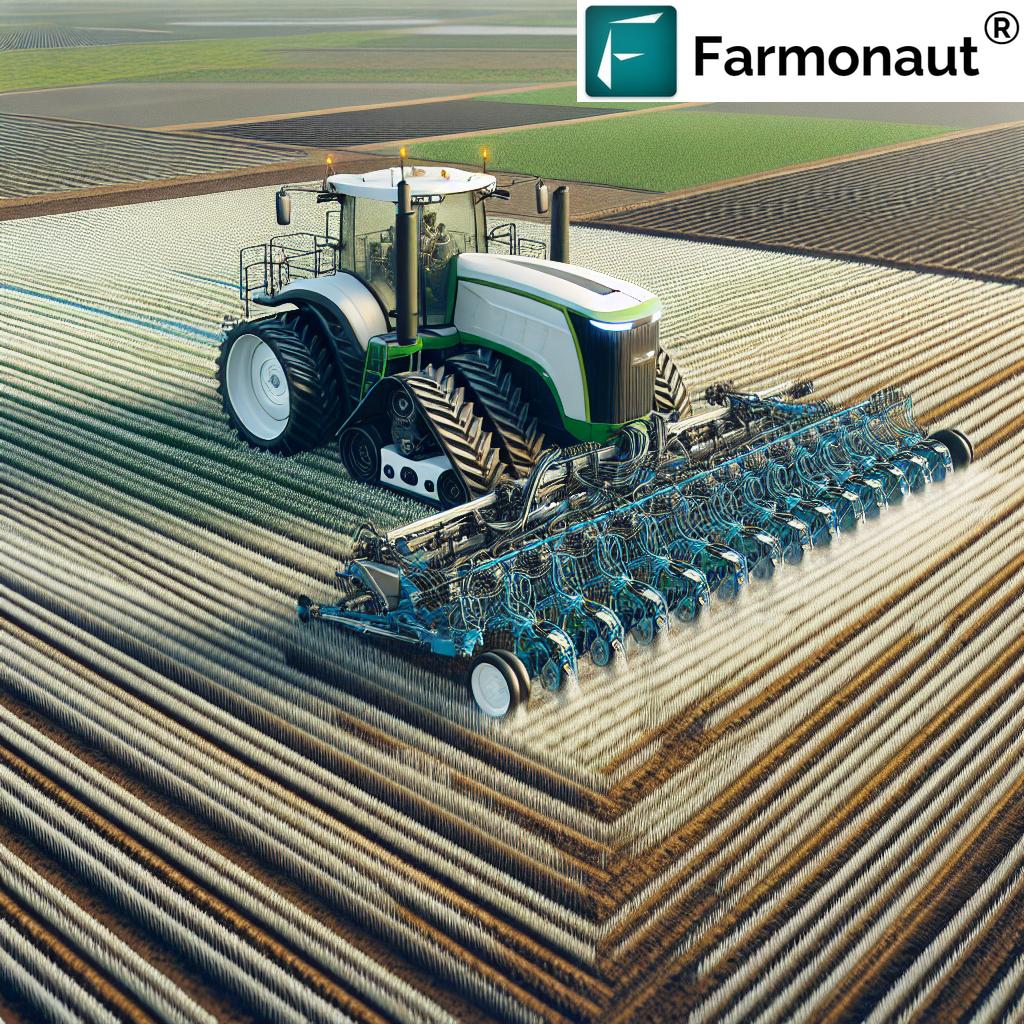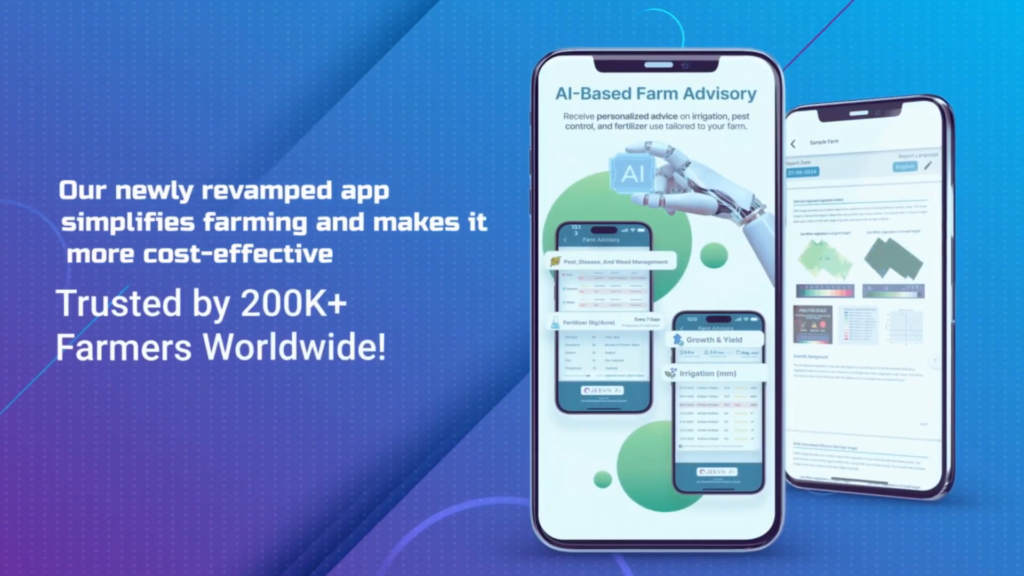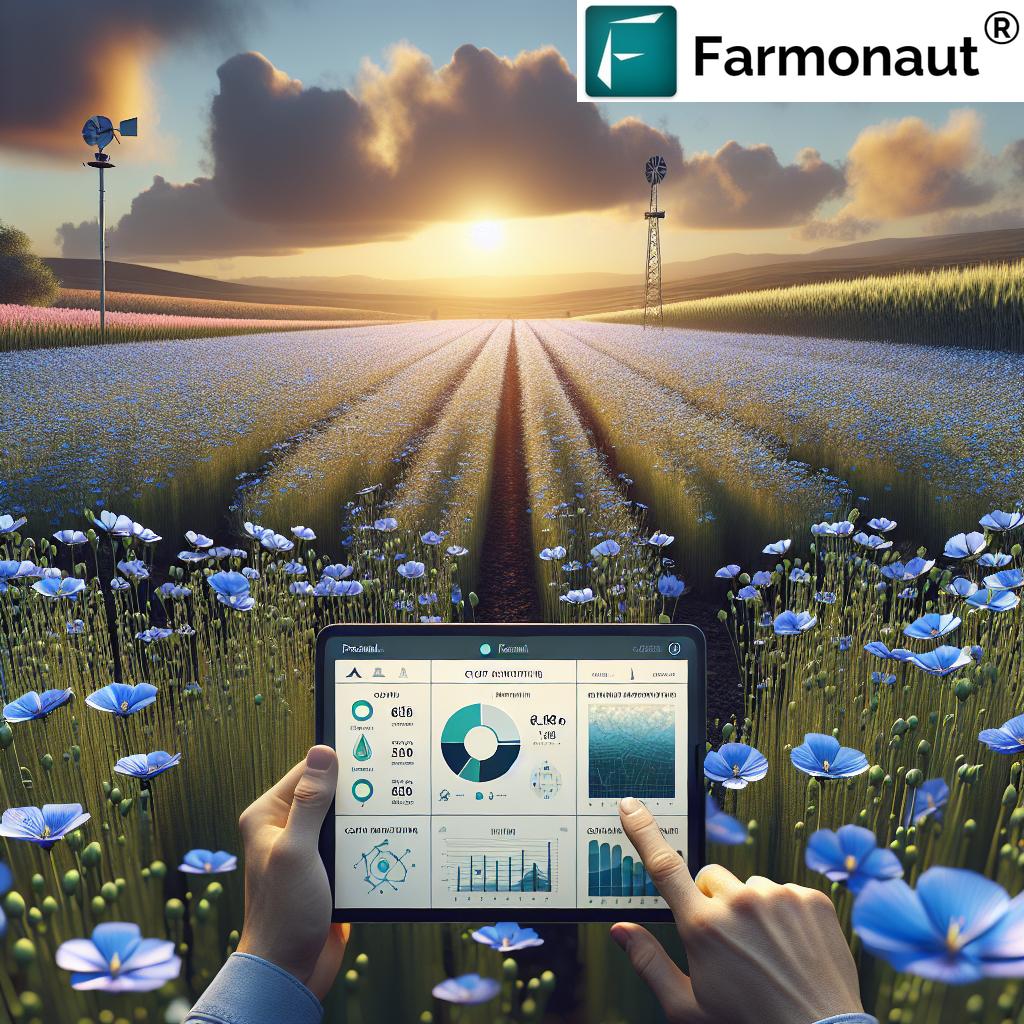Conserving Soil: AI & Cover Crops for Water Conservation
- Introduction: The Pillars of Sustainability in 2025
- Soil Conservation Challenges: Why Conserving Soil Remains Critical
- Cover Crops for Soil Conservation: Approaches & Ecological Advantages
- AI in Water Conservation: Revolutionizing Water Management
- Data-Driven Solutions and AI Integration: The 2025 Scenario
- Comparative Benefits Table: Soil & Water Conservation Practices
- Applications in Forestry and Ecosystems: Restoring Land & Increasing Biodiversity
- Farmonaut’s Role in AI, Soil & Water Conservation
- Moving Toward a Resilient Future: Conclusions & Next Steps
- Frequently Asked Questions
Introduction: The Pillars of Sustainability in 2025
In an era marked by escalating climate challenges and increasing pressures on natural resources, conserving soil, protecting water, and managing these resources efficiently have become the critical pillars underpinning sustainable agriculture, forestry, and ecosystem health. By 2025, two transformative innovations—cover crops for soil conservation and AI in water conservation—are revolutionizing how land managers, farmers, and foresters safeguard ecosystems while optimizing productivity and resilience.
This comprehensive guide explores the urgent need for soil conservation, the ecological and agronomic benefits of cover cropping, and the deployment and integration of artificial intelligence in water management. We’ll also highlight the cutting-edge role that satellite technology companies like Farmonaut play, making AI-driven data and monitoring accessible for agriculture, forestry, and ecosystem management worldwide.
Soil Conservation Challenges: Why Conserving Soil Remains Critical
Soil erosion and degradation are enduring and intensifying global threats to agricultural productivity, food security, and ecosystem integrity. Decades of continuous tillage, monoculture cropping, deforestation, and unsustainable land management have led to nutrient depletion, loss of soil structure, and declining soil health.
Key Threats Among Agricultural and Forestry Landscapes
- Continuous Tillage: This disrupts soil structure, promotes crusting and compaction, and accelerates erosion.
- Monoculture Practices: Growing the same cash crop repeatedly drains specific nutrients and reduces biodiversity.
- Deforestation: Removing protective vegetation exposes soil surfaces to raindrop impact, wind erosion, and rapid organic matter loss.
- Escalating Pressures: Climate variability, water scarcity, and increased resource use for intensive agriculture are aggravating soil degradation worldwide.
Maintaining fertile, resilient soil is not merely an environmental goal—it is the bedrock for global food security, carbon sequestration, climate mitigation, and healthy rural economies.
Cover Crops for Soil Conservation: Approaches & Ecological Advantages
Cover crops—plants grown primarily to protect and enrich soil between cash crop cycles—have emerged as one of the most ecological and cost-effective soil conservation strategies. By 2025, cover cropping is widely utilized across diverse local climates, due to improved seed varieties and precise agronomic management tailored to local conditions.
How Cover Crops Work for Soil Conservation
- Living Mulch: Cover crops form a dense vegetative layer over the soil, protecting against wind and water erosion.
- Root Structure: Varied root systems reduce compaction, improve soil structure, and enhance organic matter content.
- Microbial Diversity: Cover cropping promotes microbial activity and nutrient cycling, improving soil fertility and suppressing pathogens.
Studies have shown, conservative estimates indicate that cover crops for soil conservation can reduce soil erosion rates by up to 96% in susceptible environments, conservatively protecting vital soil and water resources.
Which Species Are Commonly Used?
- Legumes: Fix atmospheric nitrogen and improve soil nutrient balances (e.g., clover, vetch, peas).
- Grasses: Fast-growing root mats anchor soil (e.g., annual ryegrass, oats, barley).
- Brassicas: Deep taproots break compacted soils and suppress pests (e.g., radish, mustard).
Key Agricultural Benefits of Cover Crops
- Reduce Erosion: Cover crops absorb the raindrop impact, stabilize soil particles, and reduce runoff.
- Increase Organic Matter: Ongoing root and top growth increases organic matter and long-term soil health.
- Enhance Nutrient Cycling: Roots scavenge and cycle nutrients that might otherwise be lost.
- Suppress Weeds & Diseases: Dense living mulch outcompetes weeds and disrupts pest cycles.
- Improve Water Retention: Improved soil structure enhances water infiltration and moisture holding capacity.
By maintaining a protective vegetative layer in offseason periods and between cash crops, cover crops for soil conservation help retain topsoil, support biodiversity, and enhance the resilience of agricultural sustainable systems.
Discover regenerative and cover cropping strategies for soil health and climate-smart agriculture in 2025.
Ecological Advantages for Forestry, Land Restoration, and Ecosystem Health
In forestry and land restoration, cover cropping and underplanting strategies assist in:
- Preventing Soil Compaction: Establishing deep-rooted species fosters seedling growth and reduces soil compaction.
- Restoring Degraded Lands: Vegetative cover restores fertility and arrest erosion in degraded lands.
- Improving Carbon Sequestration: By increasing organic matter and biomass, cover crops facilitate higher carbon storage—a crucial factor in climate change mitigation.
- Increasing Biodiversity: Supporting a wider range of plant and microbial species strengthens the overall ecosystem.
Best Practices for 2025: Optimizing the Use of Cover Crops
Today’s agronomic management for cover cropping incorporates advanced, tailored methods for different local climates:
- Utilize improved seed varieties better adapted to pests and variable conditions.
- Staggered planting and termination times tailored to the cash crop cycle for maximum benefit.
- Integration with reduced tillage, preserving soil structure and reducing loss.
- Data-driven selection of cover species to target nutrient needs, soil health challenges, or pest suppression.
In essence, cover cropping is now both a traditional and high-tech solution, supporting the sustainable management of land resources and playing a foundational role in future soil conservation strategies.
Learn how healthy soil and water are deeply interconnected with agricultural and ecosystem success.
AI in Water Conservation: Revolutionizing Water Management
Water scarcity is a global challenge that agricultural and forestry managers increasingly face. The imperative for managing water efficiently has never been more urgent. In 2025, artificial intelligence (AI) in water conservation is a game-changer, giving farmers and land managers precision tools to allocate, monitor, and apply water optimally.
What is AI in Water Conservation?
AI in water conservation involves using data analytics, machine learning, and predictive tools to analyze variables like soil moisture, crop requirements, weather patterns, and landscape conditions, enabling smarter water management.
- Soil Moisture Sensors: Collect real-time moisture data, transmitting insights to AI-driven management systems.
- AI-Adaptive Irrigation: Algorithm-powered platforms synchronize irrigation events and water volumes, matching crop demand with minimal waste.
- Drones & Remote Sensing: Drones and satellites (like those leveraged by Farmonaut) scan landscapes for hydrological health, stress, and leaks.
See how AI-driven remote sensing and drones are transforming field operations in 2025.
Primary Benefits of AI in Water Conservation
- Precision Irrigation: Precise control of water use ensures crops are neither under- nor over-irrigated.
- Resource Efficiency: AI-driven irrigation can cut agricultural water usage by up to 30%, addressing both economic and ecological needs.
- Leak Detection: Drones identify water loss through pipeline or canal defects, reducing unnoticed resource depletion.
- Drought Prediction: Analyzing soil and vegetation health, AI tools enable risk-informed management and proactive water storage.
Explore how satellites and AI algorithms measure water indexes and transform precision irrigation in farms.
Integration with Traditional Water Conservation Strategies
- Contour Bunding & Terracing: AI identifies optimal zones for traditional water-harvesting structures, maximizing groundwater recharge and erosion control.
- Water Storage Systems: Advanced AI modeling helps design and maintain storage ponds, check dams, and reservoirs for efficient irrigation management.
By integrating modern AI with trusted conservation practices, land managers are equipped to combat both current water scarcity and the anticipated future challenges posed by climate change.
Supporting Data-Driven Water Management
Beyond direct control, AI in water conservation offers long-term support through monitoring, forecasting, and decision-making—optimizing water productivity on every acre.
See advanced AI monitoring systems for soil moisture and learn how they benefit precision agriculture.
Data-Driven Solutions and AI Integration: The 2025 Scenario
In 2025 and beyond, the landscape of soil and water conservation is characterized by the integration of data-driven, AI-powered insights into everyday decision-making for agriculture, forestry, and ecosystem management.
- Continuous Data Collection: Soil, water, and crop parameters are monitored in real time via sensors, drones, and satellites.
- AI Algorithms: Advanced machine learning models analyze complex datasets from multiple sources (e.g., satellite NDVI/NDWI, ground sensors, weather data).
- Optimized Decisions: AI platforms prescribe customized irrigation, nutrient management, and cover cropping schedules—improving productivity while minimizing losses.
This technology revolution is not limited to large commercial farms. With affordable Farmonaut apps and APIs, farmers and resource managers of all scales are empowered to safeguard their crops, soil, and water—enabling a sustainable future across landscapes.
Learn to monitor soil health, crop status, and irrigation needs using AI-powered web systems.
For developers or agronomic teams wishing to integrate satellite-based soil and water analytics into their platforms, Farmonaut’s comprehensive API (available here and see API documentation) offers seamless access to satellite soil moisture, vegetation, water indices, and climate-adaptive insights.
See how the Jeevn AI advisory system provides actionable satellite-driven crop, soil, and water recommendations.
Comparative Benefits Table: Soil & Water Conservation Practices
Understanding the relative advantages of conservation methods helps prioritize investment and land management actions. The table below compares key soil and water conservation practices for 2025:
| Conservation Practice | Method Description | Estimated Soil Erosion Reduction (%) | Estimated Water Retention Increase (%) | Impact on Biodiversity | Applicability (Agriculture/Forestry/Ecosystem) | Notes |
|---|---|---|---|---|---|---|
| Traditional Cover Crops | Planting legumes, grasses, or brassicas as living mulch between or during offseason periods. | 60–96% | 30–50% | High: Supports microbial and faunal diversity. | All | Most effective in areas with moderate rainfall and established cropping systems. |
| AI-Driven Irrigation | Automated soil moisture sensors and AI-based scheduling for precise water delivery. | 40–70% | Up to 30–45% | Indirect: Healthier crops promote natural diversity. | Agriculture/Forestry | Optimizes water use but requires technology infrastructure. |
| Cover Crops + AI Monitoring | Combining cover crop strategies with AI-powered soil, water, and vegetation data analysis. | Up to 98% | 40–65% | Very High: Enhances entire ecosystem resilience. | All | Most comprehensive for climate resilience; promotes both productivity and biodiversity. |
| Contour Terracing & Bunding | Traditional land-shaping practices for reducing surface flow, enhanced by remote sensing for site selection. | 30–70% | 30–40% | Medium: May create micro-habitats, but disrupts the original landscape. | Agriculture/Forestry | Works best in sloped terrains, now guided by AI mapping. |
| Mulch & Organic Amendments | Application of straw, compost, or crop residues over soil surface to protect and enrich it. | 40–80% | 25–40% | Medium-High: Supports soil life and moderate habitat complexity. | Agriculture/Ecosystem | Useful in both low-tech and advanced systems. |
Applications in Forestry and Ecosystems: Restoring Land & Increasing Biodiversity
The role of soil and water conservation extends beyond traditional farms into forestry, reforestation, mining reclamation, and broader ecosystem restoration in 2025. These practices are increasingly recognized as pillars for climate change mitigation, carbon sequestration, and ecological health.
Key Approaches in Forestry & Land Restoration
- Using underplanted cover crops and grasses to stabilize degraded lands during forest restoration.
- Reducing soil compaction with deep-rooting brassicas, fostering seedling growth and better retention of topsoil.
- Monitoring watershed health with AI-enabled remote sensing to safeguard against droughts and identify critical intervention points.
- Enhancing carbon sequestration and biodiversity for climate and ecosystem resilience.
When cover crops are deployed in reforestation or forest plantations, they not only suppress weeds, but also build organic matter and support microbial cycling vital for long-term soil health.
For those managing large forest holdings or seeking AI-powered, satellite-based land monitoring, Farmonaut’s web and mobile platform provides real-time insights on vegetation health, soil moisture, and environmental impacts. These tools are invaluable for:
- Tracking forest and plantation health
- Advising restoration strategies with data-driven AI (Learn more here)
- Quantifying carbon sequestration (Farmonaut Carbon Footprinting Solution)
Effective soil and water conservation thus underpins not only productivity, but the very future of sustainable forestry and ecosystem management.
See how AI and satellite monitoring help solve water crises and safeguard large agricultural landscapes.
Farmonaut’s Role in AI, Soil & Water Conservation
As a satellite technology pioneer, Farmonaut offers a suite of affordable, real-time monitoring and AI-based advisory solutions designed for conserving soil, deploying cover crops, and optimizing water use—all available via Android, iOS, and web apps.
- Satellite Monitoring: Access vegetation indexes (NDVI), soil moisture maps, and resource analytics for precise field and forest management.
- Jeevn AI Advisory: Personalized strategies for crop, land, and water management derived from satellite and local data.
- Blockchain-Based Traceability: For agricultural and forestry products; creates transparency in resource and product movement (here).
- Environmental Impact Monitoring: Real-time carbon footprint tracking, ensuring compliance and sustainability (here).
- Fleet & Large-Scale Management: Tools for optimizing agricultural transport, reducing cost and emissions (learn more).
- Crop Loan & Insurance: Satellite-based verification for lenders and insurers, reducing risk and improving finance access (details).
- Scalable Platform: From family farms to nationwide government programs, Farmonaut services scale affordably & efficiently.
Our integration of satellite, AI, and data analytics places powerful, next-generation resource management into the hands of every user—no matter the field size or location.
To start using Farmonaut, download the app or access the web interface:
API and Developer Documentation: Seamless integration for advanced users: API | Docs
Organizations choosing Farmonaut benefit from cost-effective, scalable subscriptions:
Farmonaut is committed to making AI-driven soil and water conservation accessible, spurring more sustainable agriculture, forestry, and ecosystem stewardship.
Moving Toward a Resilient Future: Conclusions & Next Steps
As we move through 2025 and beyond, the world continues to face the combined challenges of land degradation, climate change, soil erosion, water scarcity, and escalating pressures on natural resources. The evidence is clear: the most robust, resilient agricultural and forestry systems will be those that integrate the ecological power of cover crops with the precision of artificial intelligence in water management.
- Cover crops offer a time-tested, increasingly sophisticated approach for conserving soil, maintaining fertility, and supporting biodiversity.
- AI-driven water conservation ensures every drop counts, optimizing productivity and protecting ecosystem health in the face of climate volatility and resource scarcity.
- Integrated data-driven management equips farmers, foresters, and land managers to safeguard their livelihoods and the planet.
Together, these pillars are revolutionizing the future of agriculture and forestry—ensuring that food, timber, and healthy ecosystems remain secure in an increasingly uncertain environmental landscape.
In this new era, conserving soil and managing water efficiently are not just sustainability goals—they are the foundation for long-term ecosystem and economic resilience.
Frequently Asked Questions: Soil & Water Conservation with Cover Crops and AI
A: Cover crops are plants grown mainly to protect, enrich, and stabilize soil between main crop cycles. They act as living mulch, reducing erosion, retaining moisture, increasing organic matter, fixing nitrogen, and suppressing weeds—vital for sustainable, biodiverse, and productive agriculture.
Q: How does artificial intelligence improve water conservation?
A: AI uses soil moisture sensors, climate data, and crop models to schedule irrigation, detect leaks, and predict water needs with precision. This minimizes waste, reduces cost, and boosts productivity, while supporting sustainable water management under increasing scarcity.
Q: Do cover crops and AI only benefit large farms?
A: No. Today, affordable technology—like ours at Farmonaut—makes these tools accessible for farms, plantations, and land managers of any size, everywhere from small fields to national forestry programs.
Q: Can these solutions help with climate change?
A: Absolutely. Cover cropping enhances soil carbon sequestration and resilience, while AI-powered water management reduces resource waste, both contributing to climate change mitigation and adaptation in agriculture and forestry.
Q: What tools does Farmonaut provide for monitoring soil and water health?
A: Farmonaut offers satellite-based soil and water analytics, AI-driven crop and irrigation advisory, blockchain traceability, large-scale resource management, and environmental impact monitoring—all accessible via web, Android, iOS apps, and API.
Q: Where can I access Farmonaut services?
A: Download the Farmonaut app for Android, iOS, or use our web system online via this link. For developers, API details are available here.
Summary
In the midst of 2025’s escalating climate and resource challenges, conserving soil and managing water efficiently are essential pillars for sustainable agriculture and forestry. Cover crops for soil conservation and AI in water conservation are revolutionizing land management, driving ecosystem resilience, productivity, and sustainability. Leveraging these approaches, especially via accessible satellite platforms like Farmonaut, ensures that farmers, foresters, and land managers can protect their most precious assets—soil, water, and biodiversity—while preparing for a more sustainable, secure future.
Begin your journey toward sustainable, data-driven soil and water stewardship now—empowering your land and our world for 2025 and beyond.












